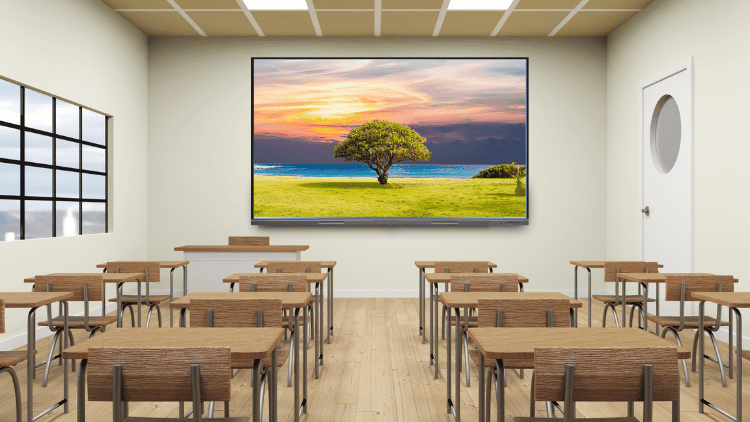
In today’s rapidly evolving technological landscape, educational institutions, corporate offices, and training centers are all seeking ways to enhance collaboration, communication, and efficiency. One of the standout innovations in this realm is the interactive flat panel display. As organizations consider technology upgrades, understanding the cost-benefit dynamics of investing in these modern displays is crucial. This article delves deep into the analysis, helping decision-makers make informed investments.
Understanding Interactive Flat Panel Displays
An interactive flat panel is a large touchscreen display designed for collaborative use in classrooms, boardrooms, and training environments. It combines the functionalities of a whiteboard, projector, computer, and speaker system into a sleek, all-in-one device. Modern interactive flat panel displays offer ultra-high-definition (UHD) resolution, multi-touch support, integrated software, and wireless connectivity, among other features.
Before diving into costs and benefits, it’s important to recognize the transformative potential these devices hold. They are not merely replacements for old whiteboards or projectors; they redefine the way information is presented, discussed, and retained.
The Initial Cost Considerations
Investing in interactive flat panel displays comes with a noticeable upfront cost. Depending on the brand, size (typically between 55–98 inches), and feature set, prices can range from $1,500 to over $8,000 per unit. Additional costs might include:
- Installation charges
- Warranty and extended support
- Training sessions for users
- Upgrades for compatible software or networking hardware
For larger institutions or enterprises equipping multiple rooms, these costs can multiply quickly. However, it is critical to frame these expenditures within the broader context of total cost of ownership (TCO) and return on investment (ROI).
Operational and Maintenance Costs
Compared to traditional setups like projectors and whiteboards, interactive flat panel displays typically entail lower long-term operational costs. Projectors require bulb replacements, regular cleaning, and often cooling system maintenance. Whiteboards wear out and need constant replacement markers and erasers.
By contrast, modern interactive flat panels are designed for durability. With lifespans often exceeding 50,000 hours, many units operate efficiently for 7–10 years with minimal maintenance.
Electricity consumption is another consideration. While large panels do consume significant power, they are increasingly energy-efficient and come equipped with power-saving modes. Factoring in maintenance and energy costs over several years often tilts the cost-benefit balance heavily in favor of flat panels.
Productivity and Learning Benefits
One of the most compelling arguments for investing in interactive flat panel technology is the immense boost to productivity and engagement. In educational settings, studies show that visual and interactive content significantly improves knowledge retention rates among students.
Similarly, in corporate settings, meetings conducted using interactive flat panel displays are often more engaging and efficient. Features such as real-time annotation, screen sharing, and instant saving of meeting notes reduce time wasted and encourage active participation.
Moreover, the ability to integrate with video conferencing tools, cloud storage, and third-party applications ensures that interactive flat panels are not just standalone devices, but central nodes in a modern communication network.
Enhancing Collaboration and Communication
Traditional classrooms and boardrooms have always faced challenges in maintaining consistent engagement levels. Chalk and talk or one-way PowerPoint presentations limit active participation.
The introduction of interactive flat panel displays changes this dynamic entirely. Teachers can invite students to solve problems directly on the screen. Meeting participants can simultaneously annotate documents from different devices. Remote attendees feel more involved thanks to vivid, real-time visualizations.
Thus, an interactive flat panel acts as a catalyst for collaboration, enhancing not just productivity but also organizational culture around communication.
Reduction in Ancillary Equipment Costs
When you install an interactive flat panel display, you eliminate the need for many supplementary devices, such as:
- Projectors
- Projection screens
- External speakers
- Whiteboards
- Document cameras
Each of these items entails its own purchase, maintenance, and upgrade costs. By consolidating these functions into a single device, the interactive flat panel simplifies IT infrastructure and reduces both direct and indirect costs.
Moreover, the reduction in cables, connectors, and adapters also contributes to a cleaner, more organized, and safer environment, minimizing trip hazards and maintenance headaches.
Scalability and Future-Proofing
Organizations often grapple with technology obsolescence. A wise investment must withstand technological shifts. Interactive flat panel displays are designed with scalability in mind. Features like firmware updates, compatibility with newer devices, and modular accessory support ensure that these devices remain relevant for years.
Instead of facing major overhauls every few years, organizations can enjoy incremental upgrades, maximizing their investment and reducing financial strain over time.
Environmental Impact and Sustainability
Sustainability is an increasingly important consideration for institutions and companies alike. Interactive flat panels support eco-friendly practices by reducing paper consumption (no need for printed handouts), eliminating projector bulb waste, and minimizing e-waste by consolidating multiple devices into one.
Some manufacturers also emphasize eco-friendly materials and energy-efficient production processes. Choosing such products not only benefits the planet but can also enhance an organization’s reputation in an environmentally conscious world.
Training and Transition Costs
While the transition to interactive flat panel displays brings myriad benefits, it is not without its challenges. Staff and students may require training to unlock the full potential of these devices. However, most modern panels come with intuitive interfaces, and manufacturers often provide free or low-cost training resources.
Over time, the initial learning curve is easily offset by the gains in efficiency, collaboration, and educational outcomes. Still, it’s important for decision-makers to budget for onboarding programs as part of their cost analysis.
Real-Life Case Studies
A growing number of case studies validate the value proposition of interactive flat panels.
For example, a mid-sized public school district in Texas replaced outdated whiteboards and projectors with interactive flat panel displays in all classrooms. Over three years, they observed:
- A 30% increase in student engagement scores
- A 20% improvement in standardized test performance
- Annual savings of $50,000 on projector bulb replacements and related maintenance
Similarly, a multinational consulting firm equipped its global meeting rooms with interactive flat panel displays. They reported a 25% decrease in meeting times and a significant improvement in cross-office collaboration and decision-making speed.
Such examples highlight that the real-world benefits often far exceed the initial projections.
Potential Drawbacks and Mitigation
No investment is without risks. Potential drawbacks include:
- High initial capital expenditure
- Resistance to change from some users
- Technical issues with hardware or software
However, most of these risks can be effectively managed by:
- Careful vendor selection with strong support services
- Clear internal communication about the benefits
- Regular maintenance and software updates
When managed well, the risks are dwarfed by the substantial advantages an interactive flat panel offers.
Conclusion: A Strategic Investment for the Future
When conducting a thorough cost-benefit analysis, it becomes clear that interactive flat panel displays are not just technological luxuries but strategic investments. The initial costs are easily justified when you account for long-term operational savings, enhanced productivity, better engagement, environmental benefits, and future-proofing capabilities.
Organizations that invest in interactive flat panel technology position themselves at the forefront of innovation, ready to tackle the challenges of a digital-first world with confidence and agility.
Ultimately, the decision to invest should align with broader organizational goals — whether they focus on enhancing learning outcomes, improving business processes, fostering collaboration, or achieving sustainability milestones.
As technology continues to evolve, those who embrace these advancements today will be better equipped to lead tomorrow.







